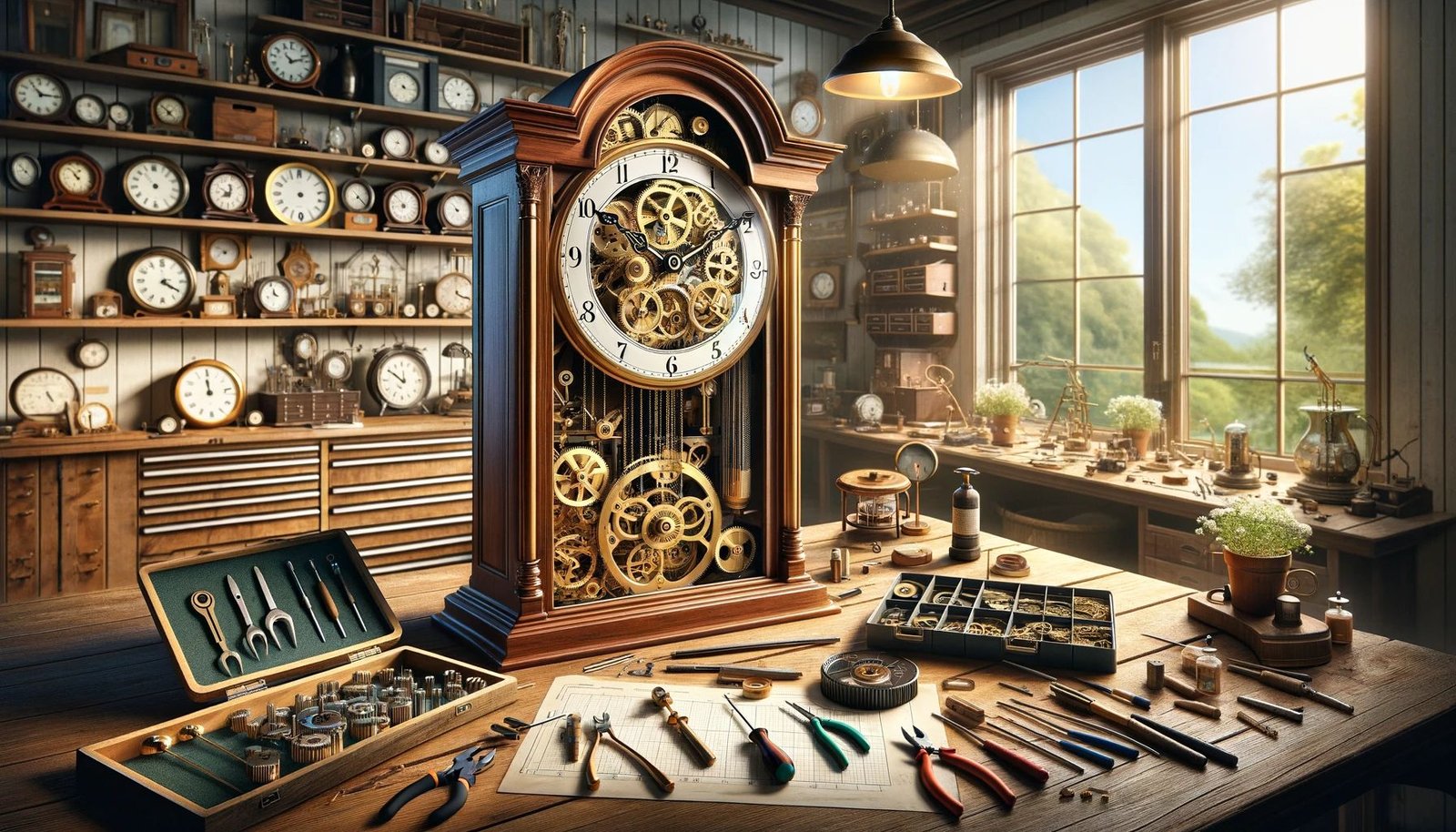Welcome to our comprehensive guide on How to Fix a Pendulum Wall Clock. Whether you’re a seasoned clock enthusiast or a beginner looking to tackle your first repair, this article is designed to guide you through every step with ease.
A pendulum wall clock is a timeless piece of decor with intricate mechanics that require regular maintenance and occasional repairs. In this article, we will cover common issues, detailed instructions for repair, maintenance tips, and troubleshooting advice to keep your pendulum wall clock ticking perfectly.
Understanding Your Pendulum Wall Clock
Pendulum wall clocks have a captivating history and operate using fascinating mechanical principles. Understanding the essential components and mechanics of your clock is crucial before attempting any repairs.
Read More:
- How to Fix Wall Clock Not Working: Quick Solutions!
- How to Stop Wall Clock from Ticking: Silent Time Tips
Anatomy of a Pendulum Wall Clock
Pendulum wall clocks consist of several key components:
- Frame: The outer structure that holds the clock’s internal mechanisms.
- Dial: The clock face displaying the time and possibly the date.
- Pendulum: A weighted rod that swings back and forth to regulate timekeeping.
- Weights: Driven by gravity, these power the clock’s movement.
- Chime Mechanism: Provides an audible indication of the time at regular intervals.
- Movement: The clock’s internal engine that drives the hands and pendulum.
Types of Pendulum Wall Clocks
There are various types of pendulum wall clocks, each with its unique features:
- Regulator Clocks: Known for their precision and accuracy.
- Cuckoo Clocks: Featuring a decorative bird that pops out to announce the time.
- Grandfather Clocks: Tall, freestanding clocks renowned for their elegant appearance and impressive chimes.
Understanding the specific type of pendulum wall clock you own will aid in diagnosing and resolving issues effectively.
Common Problems and Diagnostics
Before delving into the repair process, it’s essential to diagnose the issues your pendulum wall clock might be facing.

Common Problems
- Irregular Timekeeping: The clock consistently runs fast or slow.
- Stopped Pendulum: The pendulum fails to swing or stops unexpectedly.
- Chiming Issues: The clock’s chimes may sound off or fail to align with the correct time.
- Winding Problems: Difficulty winding the clock or over-winding leading to malfunction.
Diagnostic Steps
To diagnose these issues, follow these steps:
- Observation: Observe the clock’s behavior over an extended period to identify patterns.
- Listening Test: Listen for any unusual sounds or irregularities in the clock’s operation.
- Visual Inspection: Examine the pendulum, weights, hands, and chime mechanism for any visible issues.
Pre-Repair Checklist
Safety Tips
Before commencing any repairs, ensure the following safety measures:
- Power Off: If your clock is electric, unplug it from the power source.
- Protective Gear: Equip yourself with safety goggles and gloves.
- Stable Work Surface: Repair the clock on a stable, clutter-free surface to prevent accidents.
Workspace Preparation
Prepare your workspace by:
- Gathering Materials: Ensure you have the necessary tools and materials for the repair.
- Organizing Space: Arrange your tools and a well-lit workspace for optimal visibility.
- Referencing Guides: Have the clock’s instruction manual or relevant repair guides on hand.
Step-by-Step Repair Guide

Setting Up Your Clock
- Placement: Position the clock on a stable surface and ensure it is level to facilitate consistent timekeeping.
- Pendulum Activation: Gently initiate the pendulum’s swinging motion to kickstart the clock’s operation.
- Time Reset: Set the clock’s hands to the correct time and ensure they move freely without obstruction.
Adjusting the Chimes
Chiming issues can often be resolved by adjusting the chime mechanism:
- Alignment: Ensure the chimes correspond with the correct time by adjusting the alignment of the chime hammers.
- Melody Selection: If your clock offers multiple chime melodies, ensure the correct melody is selected.
Regulating Timekeeping
To regulate your pendulum wall clock’s timekeeping accuracy, follow these steps:
- Pendulum Adjustment: Move the pendulum bob up or down to alter the pendulum’s effective length, thereby regulating its speed.
- Nut Adjustment: Turn the pendulum nut to the left if the clock is running fast, or to the right if it’s running slow.
Fixing Stopped Pendulums
Address the common issue of a stopped pendulum by:
- Pendulum Swing: Investigate and remedy any obstructions preventing the pendulum from swinging smoothly.
- Power Supply: Ensure the clock’s weights have descended to their lowest point to provide the necessary power for the pendulum’s movement.
Solving Winding Issues
Prevent and address winding problems by:
- Proper Winding: Follow the clock’s specific winding instructions, avoiding excessive force when winding.
- Over-Winding Resolution: If the clock has been over-wound, delicately release the tension to restore normal operation.
Advanced Repairs
Addressing Escapement Issues
The escapement is a critical component responsible for releasing the clock’s gear train. If you encounter escapement issues:
- Cleaning: Dust and debris can hinder escapement operation, necessitating thorough cleaning.
- Lubrication: Apply clock-specific lubricants to essential escapement components for smooth operation.
Dealing with Mainspring Malfunctions
Mainspring issues may require advanced attention:
- Tension Adjustment: If the clock’s mainspring tension is uneven, consider readjusting it to restore balance.
- Professional Assistance: Complex mainspring repairs are best handled by experienced professionals to avoid potential damage.
Maintenance Tips
To ensure your pendulum wall clock’s longevity and performance, incorporate these maintenance practices:
- Regular Cleaning: Gently clean the clock’s exterior and internal components to prevent dust buildup.
- Lubrication: Periodically apply clock-friendly lubricants to pivotal points for smooth movement.
- Environmental Considerations: Keep your clock in a stable, moderate environment, avoiding extreme temperatures and humidity fluctuations.
Troubleshooting
Quick Fixes for Common Pendulum Wall Clock Issues
If you encounter minor issues, consider these quick fixes:
- Synchronization: Re-align the clock hands with the correct time if they become misaligned.
- Pendulum Bob: Ensure the pendulum bob is securely attached and free from interference.
Seeking Professional Help
When faced with complex or recurring issues, consulting a professional clock repair expert is advisable. They possess the expertise and resources to address intricate problems effectively.
Conclusion
In conclusion, owning and maintaining a pendulum wall clock can be a rewarding experience. With the knowledge and guidance provided in this comprehensive guide, you are equipped to identify, diagnose, and address a wide range of issues that may arise.
Remember, while some repairs can be carried out at home with diligence and care, more complex problems may necessitate expert attention. By following the outlined steps and practicing regular maintenance, you can ensure that your pendulum wall clock remains a timeless and cherished centerpiece in your home.
FAQs
How often should I lubricate my pendulum wall clock?
It is recommended to lubricate key clock components every 1-2 years, or as specified by the manufacturer, to maintain smooth operation.
Why is my clock consistently running fast?
Fast operation may indicate that the pendulum is too short. Adjust the pendulum bob to lengthen the pendulum, regulating its speed.
For further detailed information on maintaining and repairing pendulum wall clocks, you can refer to The Old Clockworks for expert advice and insights.
Read More:
- Clock Stopped Ticking? Learn How To Fix A Wall Clock That Stopped Working
- 8 Unique Wall Clocks for Living Room: Transform Your Space With Timeless Elegance.
- Bulova Wooden Atomic Analog Wall Clock Review: A Timeless Blend of Precision and Style
- AKCISOT Modern Small Wall Clocks Review: A Stylish Addition to Any Room
- Home Decor Game Changer: Learn How To Hang A Clock On The Wall-Step-by-Step Guide
- How High to Hang a Large Wall Clock: A Comprehensive Guide

